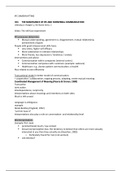Samenvatting
Complete Samenvatting Interpersoonlijke Communicatie
- Instelling
- Vrije Universiteit Amsterdam (VU)
Een uitgebreide samenvatting van het vak Interpersoonlijke Communicatie. Alle stof van het vak is inbegrepen. Alle aantekeningen van de colleges en stof uit het boek.
[Meer zien]





